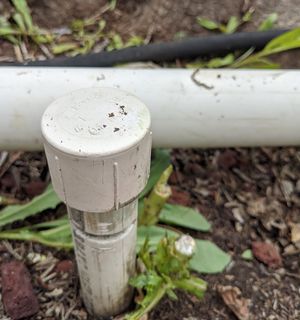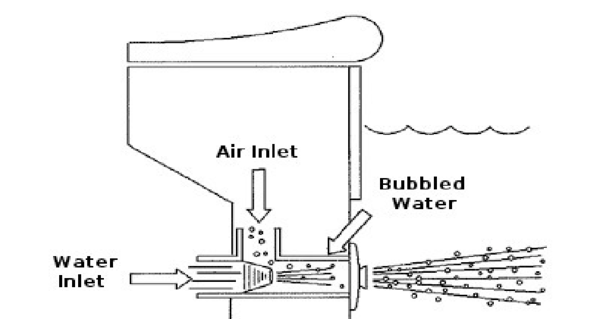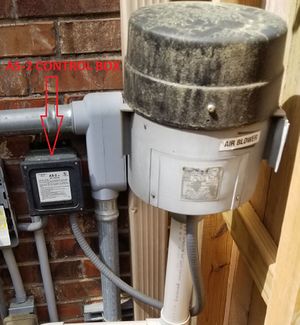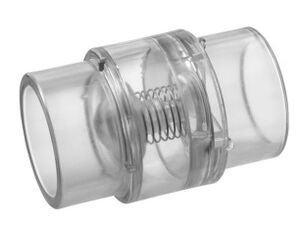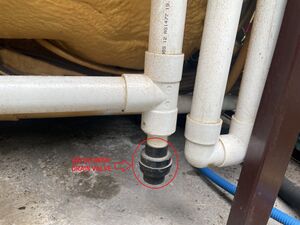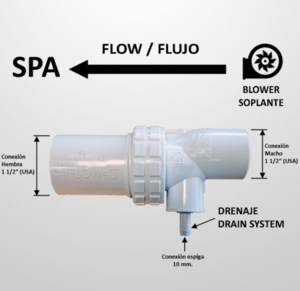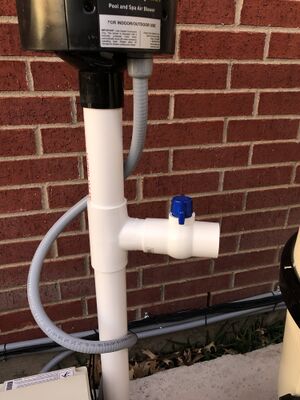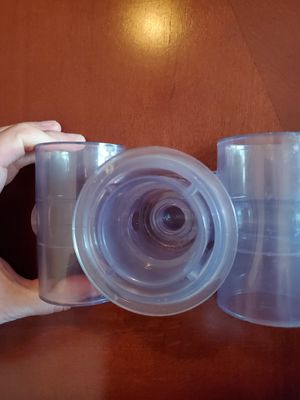Spa Air Blower
Spas connected with an in-ground pool often have an air blower to provide bubbles through the spa jets. Some spas use water venturi power to suck air through the jets without a powered air blower. On the right you can see a picture of a venturi air pipe with the air intake notch.
Blowers come in 1HP, 1.5 HP, and 2HP models. Bigger is not better for blowers. Too large a blower can overheat and shutdown or blow the water out of the spa. Polaris/Zodiac has a Blower Sizing Worksheet in the Polaris QT Blower Installation Instructions.
Vendors for air blowers include:
Spa air blowers are a commodity. They all do the same thing - blow air. The Silencer By Air Supply is supposed to be one of the most quiet. You should shop around for the best price.
Spa Air Blower Control
A spa air blower may be controlled by an automation panel with control buttons near the spa or on a control pad.
Or there may be a manual electrical switch near the spa to turn on the air blower. That electrical switch will probably be more then 5 feet from the spa to meet electrical codes.
Another type of spa blower switch uses an air switch button in the tile. The button generates a burst of air, which goes through a vinyl tube to a black AS-2 spa control box[1]. When you push the button, the blower should turn on or off.
Spa Blower Check Valve
Most spa blower installation manuals specify a check valve or Hartford loop. For example the Hayward Spa Blower Installation Manual says if the blower is to be installed more than 25 feet from the spa, it is necessary to install a Hartford loop that is 1 foot above the water line and as close as possible to the spa. And to install a check valve in a vertical orientation in an easily accessible location above water level so that it can be serviced.
Some blowers have a check valve built in so check your spa blower installation guide.
It's best to use a check valve to reduce the risk of water getting to the blower.
In addition, you don't want the blower line to fill with water because the blower has to work significantly harder at startup to clear the water out of the line.
Check valves can be[2]:
- Flo Control Air Blower 1-1/2" x 2" 1/4 lb Sping Check Valve 1050-C20
- Magic brand Pool Spa Air Blower Check Valve, 1-1/2" - 2" 1/4 lb Spring.
- Air Supply Silencer Check Valve 1/4 lb. Spring 1.5" I.D 2.0" O.D - 112500
Spa Blower Drain Valve
A drain valve serves as additional safety against water infiltration into the blower.[3]
Unlike a check valve, it is always in the open position when the blower is off, and closes again under air pressure when the blower is on. The drain valve is usually positioned at the bottom of a T-fitting
This process allows water that has nevertheless managed to infiltrate the air pipes to escape without reaching the blower and therefore risking damaging it.
An example can be found here.
The Waterway All-In-One Air Blower Check and Drain Valve combines a check valve and drain valve.[4] It installs horizontally in the air blower loop plumbing. If water manages to get past the built in check valve, it will drain out via a 3/8" (9mm) barb which drains off below a ball float. This drain valve remains closed in normal operation. if water gets past the check valve it will lift the floating ball and water will drain via the barb.
Spa Blower Airflow Control
Air Supply recommended a variable speed controller to adjust the speed of the motor blower.[5]
They said they tested the K177-2005 | KB Electronics Solid State Variable Speed AC Electric Motor Control 5.0 Max amps 230V.
It’s a 2x4 switch plate that can be installed directly onto the electrical box of the blower (you’ll need an outdoor rated switch cover if the blower is outdoors). It’s a very simple install, no more difficult than installing a standard light switch. They said they tested this particular one and it worked flawlessly. They did recommend against running it below ~50% speed, as you can run into overheating issues due to lack of airflow at a certain point.
Troubleshooting
Spa Blower Overheating
If there is a restriction in the spa air line, such as a broken check valve, or the blower is too powerful for the air line plumbing the blower can overheat and shut off.
Blower too Powerful
- Replace the blower with a lower HP
- Vent the Air Line - If the blower is too powerful you can vent the air line to reduce the back pressure to the motor. You can install a T fitting and a diverter valve (preferable to a ball valve that will stick after a few years) on the T to vent some air. Or you can drill holes in the PVC pipe to vent air. The amount of holes needed will require some experimentation.
- Venting from a T may be loud and you may want a 1" NPT Air Exhaust Muffler Plastic.
- You can also use a muffler for a central vacuum system that can fit on 2” pipes
Water Going up the Air Line to the Motor
- There should be a Hartford Loop and a check valve in the air line to prevent water flowing up to the blower
- New installations have had the air line and water lines to the spa reversed causing water flowing up to the blower.
Hartford Loop Improperly Installed
One users fix was the hartford loop was at least an inch below the water line and the plumber had used two sweep 90s. Water flowed back into the air pipe after turning off the air blower, the water filled up the pipe enough that it constricted the flow of air causing the fourth blower to die. They raised the height of the line well above the water line (we were able to verify when the spa blower was turned off that the water didn't go above the pipe) and used two hard 90s.[6]
Tips
- The water line and air line run separate to the spa jets and are combined by two inlets at the back of the jet combining the water and air
- Blower air line should have 2" pipe, not 1.5".[7]
.
- ↑ https://www.alliedinnovations.com/control-922005-001
- ↑ https://www.troublefreepool.com/threads/check-valve-for-blower.223018/post-1953965
- ↑ https://www.troublefreepool.com/threads/air-blower-is-blowing-out-at-the-exhaust.286726/post-2513890
- ↑ https://www.troublefreepool.com/threads/water-in-j-box.284937/post-2514013
- ↑ https://www.troublefreepool.com/threads/reduce-db-spa-air-blower.249775/post-2268902
- ↑ https://www.troublefreepool.com/threads/spa-blower-issues.133955/post-1273298
- ↑ https://www.troublefreepool.com/threads/spa-blower-issues.133955/post-1273298


